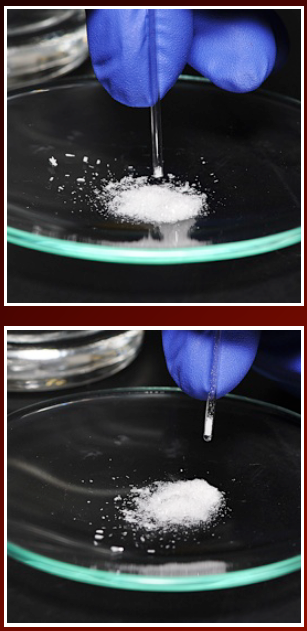Introductory Video
This video provides general background on melting point analysis. Note: If you are off campus, you must use a VPN connection to the UR network in order to access this video.
General Protocol
Preparing the Sample
1. Place a pea-sized quantity of solid on a watch glass and grind it into a fine powder using the flat blade of a microspatula. (Perform this task with a mortar and pestle if the sample consists of large crystals).
2. Press the open end of the melting point capillary into the powder until a column of 2–3 mm of solids is in the tube.
3. Turn the capillary open side up and tap the closed end on the bench top until all of the solids have fallen to the bottom end of the capillary and are tightly packed in a 2–3 mm tall column. Use caution! The small capillary tubes break easily. Hold the tube near the bottom and tap it straight up and down to prevent breakage. If the solids do not fall easily to the bottom of the capillary, it may be dropped down a narrow glass tube to provide more force. Your instructor can demonstrate this method for you.

Figure 1. Preparing the Sample
Measuring the Melting Point
1. If the expected melting point is known:
a. Heat the melting point apparatus to a temperature approximately 15°C below the expected melting point of your sample.
b. Place your capillary in the heating block. Look through the magnifying glass to ensure that you can see your solids.
c. Set the device to increase the temperature of the heating block at a rate of no more than 2°C per minute.
d. Observe the sample and record the melting range. The lower bound of the range is the temperature at which liquid first appears clearly, and the upper bound is the temperature at which no solid remains.
2. If the expected melting point is NOT known:
a. First obtain an approximate melting point by starting the apparatus at room temperature and increasing the temperature at a rate of 6 ˗ 10°C per minute.
b. Once an approximate melting point is determined, prepare a new capillary tube with fresh sample and follow the standard procedure (step 1 above).
Mixed Melting Point Analysis
To obtain a mixed melting point of two samples: On a watch glass, mix together approximately equal portions of the two samples. Use a microspatula to grind the mixture together well for at least one minute in order to ensure homogeneity. Prepare a capillary tube that contains a sample of the mixture and obtain the melting point by following the standard procedure.
Video: Digimelt Apparatus
This video provides an introduction to the Digimelt apparatus available in the organic chemistry labs at UR.
